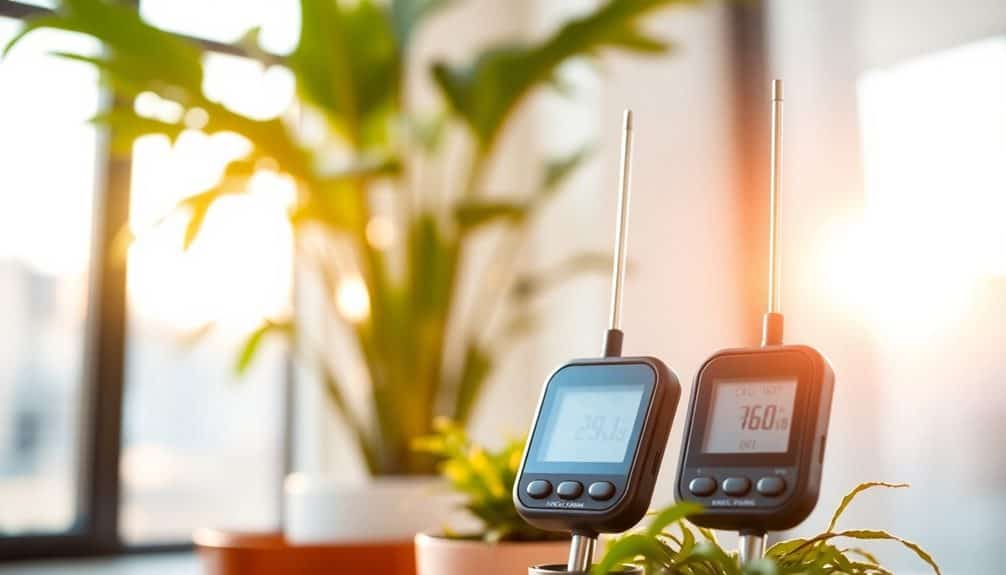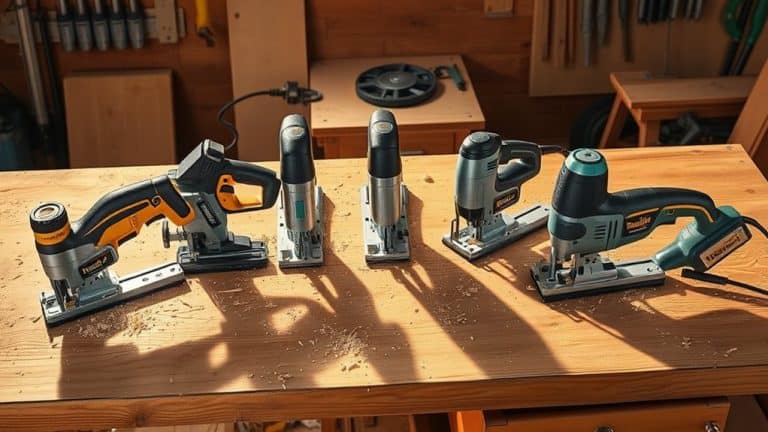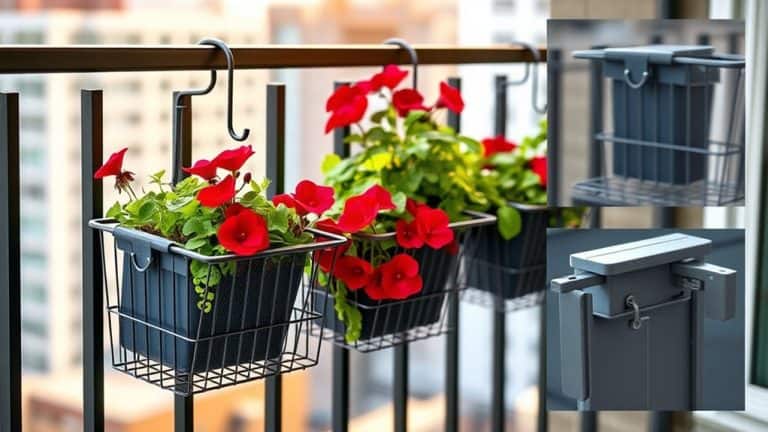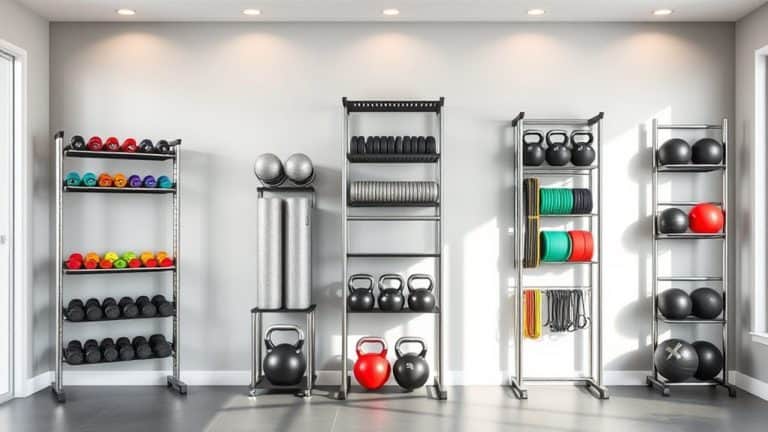This website contains affiliate links. Some products are gifted by the brand to test. As an Amazon Associate, I earn from qualifying purchases. The content on this website was created with the help of AI.
You’ll find the XLUX Soil Moisture Meter leading the pack with its user-friendly design and accurate single-probe system. The Soil Moisture Meter Plant Hygrometer offers battery-free operation with a deep-reaching 7.6-inch probe, while the 4-in-1 Digital Moisture Meter impresses with its LCD display and multiple testing capabilities. For budget-conscious gardeners, the VIVOSUN 3-in-1 Soil Tester provides basic moisture, light, and pH readings. The Aquameter’s set of 5 small sensors works well for succulents with their color-changing indicators. Let’s explore how each meter’s unique features can transform your watering routine.
Key Takeaways
- XLUX Soil Moisture Meter leads with user-friendly design, accurate single-probe readings, and proven effectiveness for managing multiple houseplants.
- The 4-in-1 Digital Soil Moisture Meter offers comprehensive plant care with moisture, pH, temperature, and sunlight measurements in one device.
- Soil Moisture Meter Plant Hygrometer provides reliable battery-free operation with a 7.6-inch probe for deep root zone measurements.
- Aquameter’s set of 5 sensors suits small succulents with color-changing indicators and continuous monitoring capabilities.
- VIVOSUN 3-in-1 Soil Tester offers budget-friendly moisture, light, and pH testing suitable for basic plant monitoring needs.
XLUX Soil Moisture Meter for Plant Water Monitoring
- Accurate Soil Moisture Detection:The XLUX Soil Moisture Meter can tell you if the soil deep inside your pot or garden is dry, moist or wet; whereas...
- Easy-to-Read Large Dial: The large dial is easy to read and includes three zones with ten scales, making it very straightforward to understand.
- Immediate Moisture Reading: Insert the probe into the soil, and without waiting, the dial will immediately display the moisture level. You can then...
If you’ve ever struggled with knowing when to water your plants, the XLUX Soil Moisture Meter offers a precise solution for both novice gardeners and plant enthusiasts. This user-friendly device features a large, easy-to-read dial with three zones and ten scales, providing immediate moisture readings upon insertion.
You’ll appreciate the single-probe design that minimizes root damage while delivering accurate measurements. The meter’s simplicity means you won’t need complex instructions – just insert and read. Users report significant improvements in their plant care routines, with some successfully managing collections of up to 40 houseplants. You’ll want to avoid leaving the probe in soil for over five minutes to prevent corrosion, and it’s not suitable for very hard soil or liquids. Many users have relied on this durable tool for years, making it a worthwhile investment for maintaining healthy plants.
Best For: Indoor and outdoor plant enthusiasts seeking accurate soil moisture measurements, from beginners to experienced gardeners who want to establish proper watering routines.
Pros:
- Simple, user-friendly design with clear, easy-to-read measurements
- Single probe minimizes root damage while providing accurate readings
- Long-lasting durability with many users reporting years of reliable use
Cons:
- Cannot be left in soil for more than 5 minutes
- Not suitable for very hard soil or direct liquid testing
- Requires regular cleaning to maintain accuracy and prevent corrosion
Soil Moisture Meter Plant Hygrometer for Garden and Plants
- Soil Moisture Meter: This single probe soil moisture meter is specially designed for testing the moisture level in the soil, helps you decide whether...
- Easy to Use:No batteries or electricity needed,just insert the water meter probe into the soil to the plant root level, the indicator pointer will...
- Accurate and Reliable: Single probe sensor is very sensitive, pointer on the dial moves quickly and display accurate values when testing soil...
Gardeners seeking a simple, reliable way to monitor plant hydration will find the Soil Moisture Meter Plant Hygrometer indispensable. This battery-free device operates through direct soil insertion, providing instant moisture readings that help prevent both underwatering and root rot.
You’ll appreciate the 7.6″ probe that reaches deep into your plants’ root zones, delivering accurate measurements for potted plants, gardens, and lawns. The single-probe sensor consistently provides reliable readings when compared to manual moisture checks, making it an effective tool for maintaining ideal plant health.
While it’s not designed for testing water directly, you’ll find this hygrometer exceptionally user-friendly and portable. Remember to wipe the probe after each use and avoid rocky soil. For both novice and experienced gardeners, this affordable moisture meter offers a practical solution for precise plant care in any setting.
Best For: Home gardeners and plant enthusiasts who want an affordable, simple way to monitor soil moisture levels and prevent over or under-watering of their indoor and outdoor plants.
Pros:
- No batteries required and provides instant readings through direct soil insertion
- Long 7.6″ probe reaches deep root zones for accurate measurements
- Portable, lightweight design makes it convenient for both indoor and outdoor use
Cons:
- Cannot be used to test water or liquids directly
- Probe needs regular cleaning and maintenance after each use
- Some users report concerns about probe durability over time
4-in-1 Digital Soil Moisture Meter with LCD Display
- 【4 in 1 function】This is a 4-in-1 multifunctional soil tester.Our soil tester fastly to measure soil moisture, pH, temperature and sunlight to...
- 【Large Screen & Backlight LCD Display】The Soil Tester uses a large LCD screen and white backlight to conveniently display and read digital...
- 【Quick Accurate measurement】The latest probe detection technology in 2024 can quickly and accurately measure the pH, moisture and temperature in...
Modern plant enthusiasts seeking thorough soil analysis will appreciate the 4-in-1 Digital Soil Moisture Meter‘s versatile capabilities. This multifunctional device measures soil moisture, pH, temperature, and sunlight intensity through a large LCD screen with white backlight.
You’ll find the meter straightforward to use – simply insert the probe 4 inches into moist soil and wait 10 seconds for accurate readings. The 45° rotating head lets you view results without bending over, while the advanced probe detection technology guarantees reliable measurements.
While you might notice some initial variations in pH readings and slightly higher temperature measurements, the device’s moisture and light detection features prove consistently accurate after a break-in period. If you encounter any issues, the manufacturer’s customer support team stands ready to help, backing their U.S. patented product with satisfaction guarantees.
Best For: Home gardeners and plant enthusiasts who want comprehensive soil monitoring with easy-to-read digital measurements for multiple plant health factors.
Pros:
- 4-in-1 functionality measures moisture, pH, temperature, and sunlight with a single device
- Large backlit LCD screen with 45° rotating head for comfortable viewing in any light condition
- Simple operation with quick 10-second readings and advanced probe detection technology
Cons:
- Initial pH readings may be inconsistent and require a break-in period
- Temperature readings tend to run slightly higher than other thermometers
- Small text display for some measurements and unclear instructions for powering off the device
VIVOSUN 3-in-1 Soil Moisture, Light and pH Tester
- 3-in-1 Soil Tester: This meter can test soil moisture, light and pH value; You can switch modes with one button; It makes gardening and plantng more...
- Compact size: With a length of 10.8 inches, you can carry it around easily; it is convenient for both indoor and outdoor gardening
- Testing Range: It has moisture range of 1-10 (dry to moist), light intensity of 0-2000 (low light to strong light) and pH level of 3.5-8 (acidic to 8...
The VIVOSUN 3-in-1 Soil Tester offers budget-conscious plant enthusiasts a simple way to monitor their plants’ essential needs. At 10.8 inches long, this battery-free device measures moisture levels (1-10), light intensity (0-2000), and pH levels (3.5-8) by simply plugging it into the soil.
While you’ll appreciate its straightforward plug-and-read design and affordability, you should be aware of its limitations. Users report mixed experiences with accuracy, particularly when measuring pH levels, which often show neutral readings regardless of actual soil conditions. The light sensor’s ability to differentiate between varying conditions is also questionable. While it’s useful for basic moisture monitoring to prevent overwatering, you might want to evaluate professional-grade sensors ($50-$320) if you need precise measurements for specific plants like succulents or pH-sensitive varieties.
Best For: Budget-conscious casual gardeners who need basic soil monitoring for common houseplants and aren’t reliant on precise measurements.
Pros:
- Simple plug-and-read design requires no batteries
- Affordable entry-level option for basic plant care monitoring
- Compact size makes it suitable for both indoor and outdoor use
Cons:
- Unreliable pH readings often show neutral regardless of actual soil conditions
- Light sensor struggles to accurately differentiate between lighting conditions
- Limited accuracy makes it unsuitable for plants requiring precise soil measurements
Aquameter, Set of 5, Plant Soil Moisture Sensor (Green, Small)
- Dimensions: 0.4 x 0.3 x 4.7 inches (small) - Intended for pot sizes of 2, 2.5, and 3 - Ideal for small succulents
- The Sustee Aquameter is a leave-in soil moisture sensor pen that can be left in the soil for continuous monitoring, unlike other moisture meters that...
- Set includes five refillable sustee watering sticks (green) - Moisture meter for house plants that has refillable replacement core - Each stick will...
Designed for small succulents and compact potted plants, the Aquameter Set of 5 moisture sensors offers continuous soil monitoring in a compact 4.7-inch design. Developed with Tokyo University of Agriculture, these green sticks feature a color-changing indicator that turns from blue to white when your plants need water.
Unlike traditional moisture meters, you can leave these sensors in the soil permanently, making them ideal for pots sized 2-3 inches. They’ll last 6-9 months before needing replacement. While many users report healthier plants and reduced overwatering, you’ll need to follow specific guidelines for best results: insert the stick near the plant’s base, wait 10 minutes for readings, and avoid watering directly on the sensor. Some users have experienced inconsistent performance, but proper usage and drainage maintenance can help guarantee reliable readings.
Best For: Plant enthusiasts with small succulents and compact potted plants who want a hands-off moisture monitoring solution and are willing to follow specific care instructions.
Pros:
- Continuous soil moisture monitoring without need for removal
- Color-changing indicator makes it easy to know when to water
- Long-lasting with 6-9 month lifespan per stick
Cons:
- Some users report inconsistent or inaccurate readings
- Limited to small pot sizes (2-3 inches)
- Requires specific watering technique to avoid false readings
Factors to Consider When Choosing Plant Moisture Meters
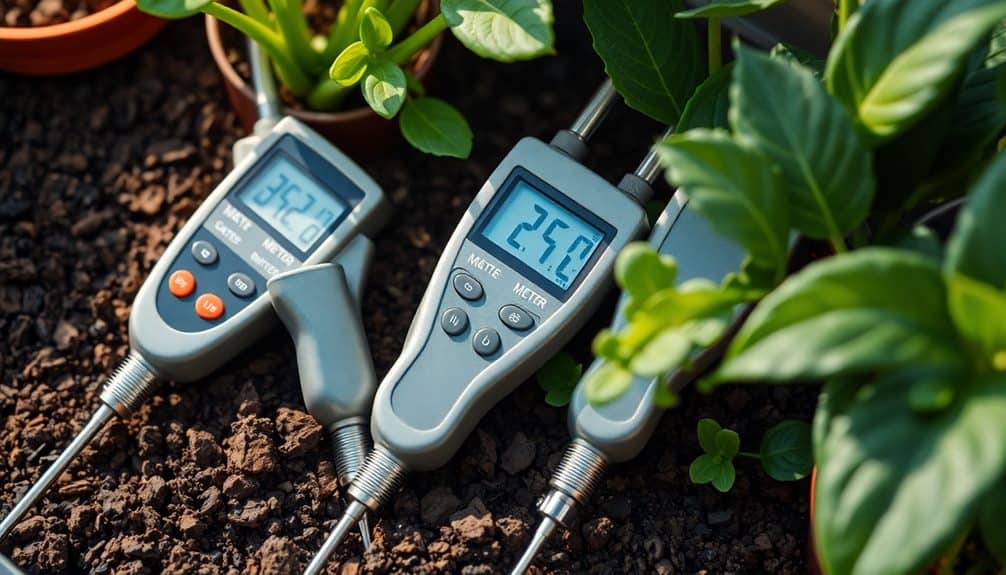
When you’re shopping for a plant moisture meter, you’ll need to evaluate several key features that affect its performance and usability. The most critical factors include the meter’s accuracy level and reliability of readings, power requirements (battery or battery-free), probe design and length for different pot sizes, and whether you want a basic moisture reader or a multi-function tool that measures additional parameters like pH and light. Your intended use location (indoor, outdoor, or both) will also influence your choice, as some meters are specifically designed for certain environments while others offer greater versatility.
Accuracy and Reading Reliability
Selecting a reliable moisture meter requires careful attention to accuracy features that can make or break your plant care routine. You’ll want to focus on models with sensitive single probe sensors that deliver quick, precise readings of your soil’s moisture levels. These advanced sensors help you avoid the common pitfalls of overwatering or underwatering that can stress or kill your plants.
When you’re testing a new moisture meter, you might notice some initial reading inconsistencies, particularly with pH measurements. Don’t be alarmed – many meters need a brief break-in period to achieve their best accuracy. During this time, it’s smart to cross-verify your meter’s readings with manual moisture checks. Simply feel the soil with your fingers and compare the results to your meter’s output to guarantee reliability.
Consider choosing a meter with a backlit display for clear readings in any lighting condition. This feature isn’t just about convenience – it helps you accurately interpret moisture levels whether you’re checking your plants in bright sunlight or dim indoor spaces. Remember, the more accurately you can read your meter, the better equipped you’ll be to maintain ideal growing conditions.
Power Source Requirements
Different power source options shape the functionality and convenience of plant moisture meters, each offering distinct advantages for your gardening needs. When you’re choosing a moisture meter, you’ll need to decide between battery-powered digital models and non-powered manual options.
Digital moisture meters typically run on batteries, giving you precise readings with easy-to-read displays. While these devices offer modern convenience, you’ll need to factor in the ongoing cost and maintenance of battery replacements. If you’re monitoring multiple plants regularly, these recurring expenses can add up over time.
In contrast, non-digital meters that work through manual probe insertion don’t require any power source. These analog devices can be more reliable long-term since they don’t depend on batteries or electrical components that might fail. You’ll simply push the probe into the soil to get your reading, making them a practical choice for everyday use.
Consider your gardening routine when selecting between powered and non-powered options. If you value digital precision and don’t mind maintaining batteries, a digital meter might suit you best. However, if you prefer a maintenance-free solution that’s always ready to use, a manual probe meter could be your ideal choice.
Probe Length and Design
The success of your moisture readings depends heavily upon the length and design of your meter’s probe. When choosing a moisture meter, you’ll want to take into account the probe length based on your specific needs. For larger potted plants and garden beds, opt for probes between 7-10 inches long, as they’ll reach deeper soil layers where root systems develop, giving you more accurate readings.
Look for a single-probe design if you’re working with plants that have delicate root systems. Single probes cause less root disturbance compared to multi-probe designs, protecting your plants’ health. You’ll also benefit from choosing a stainless steel probe, as it resists corrosion and holds up well in consistently moist soil conditions.
For enhanced usability, think about a moisture meter with a 45° rotating head. This feature lets you read measurements easily without straining to bend over. Additionally, pay attention to the probe’s tip design – fine-tipped probes offer quicker, more precise readings by minimizing soil disruption. They’re particularly useful when you need immediate moisture measurements without disturbing the surrounding soil structure.
Single Vs Multiple Functions
Beyond the physical design of moisture meters, you’ll need to decide between single-function and multi-function models. Single-function meters focus exclusively on soil moisture readings, making them straightforward to use and interpret. If you’re new to gardening or simply want to monitor watering needs, these basic meters will serve you well while being budget-friendly.
Multi-function meters, however, offer a more thorough approach to plant care. These 3-in-1 or 4-in-1 devices can measure soil moisture along with other vital factors like pH levels, light intensity, and temperature. You’ll gain deeper insights into your plants’ growing conditions, allowing you to make more informed decisions about their care. While these advanced meters provide valuable data, they do require more knowledge to interpret the various readings effectively.
When choosing between the two types, consider your gardening expertise and specific needs. If you’re primarily concerned with proper watering, a single-function meter will suffice. But if you’re looking to optimize multiple aspects of plant care and don’t mind learning to interpret different measurements, a multi-function meter could be worth the investment.
Indoor Outdoor Versatility
Selecting a moisture meter that works seamlessly across indoor and outdoor environments will maximize your gardening investment. When you’re choosing a meter for both settings, you’ll need to take into account several key factors that affect its performance and durability.
First, verify your moisture meter is lightweight and portable enough to move easily between your indoor plants and outdoor garden spaces. Look for a model that can measure moisture at various soil depths, as your outdoor plants typically have deeper root systems than houseplants. You’ll want a probe that can reach different depths to get accurate readings throughout the root zone.
Weather resistance is vital if you’ll be using your meter outdoors. Choose a model that can withstand rain, temperature fluctuations, and other environmental challenges without compromising its accuracy or functionality. While basic meters measure only moisture, you might find added value in models that offer multiple functions, such as pH and light testing capabilities. These additional features can be particularly useful when monitoring both indoor and outdoor growing conditions, helping you maintain the best plant health across all your gardening spaces.
Price and Value
Price-conscious gardeners will find moisture meters available across a wide spectrum of costs, from basic $10 models to professional-grade devices exceeding $300. When reviewing your options, you’ll need to contemplate both immediate costs and long-term value to make the best choice for your gardening needs.
Higher-priced models often come with additional features that can enhance your plant care routine. You might find meters that measure pH levels, light exposure, and temperature alongside moisture readings. While these features increase the initial investment, they can provide more thorough plant care data that justifies the cost.
Think about durability when evaluating value. A well-made meter that lasts for years can be more cost-effective than replacing cheaper models frequently. Even budget-friendly options can prove worthwhile by preventing expensive plant loss due to improper watering. You’ll want to weigh the potential savings from avoiding overwatering damage against the meter’s purchase price.
Before making your decision, review how often you’ll use the device and which features you’ll actually need. Sometimes a basic model will serve your purpose just as well as a premium option with features you may never use.
Durability and Construction
Three key aspects of durability and construction will determine how long your moisture meter lasts. First, you’ll want to focus on the probe design, with single-probe models being the most durable and least likely to cause root damage. These designs typically experience less wear and tear while maintaining accuracy throughout their lifespan.
Second, pay attention to the materials used in construction, especially if you’ll be using your meter outdoors. Look for models featuring weatherproof components that can handle various environmental conditions. The probe should be waterproof or, at minimum, corrosion-resistant to guarantee it continues functioning properly when exposed to consistently moist soil.
Ease of Operation
A truly effective plant moisture meter should be simple to operate and provide quick results. When you’re choosing a meter, you’ll want to focus on models that offer instant readings through a straightforward insert-and-read mechanism. This eliminates the need for complex setup procedures or time-consuming calibration processes.
Look for meters with clear, easy-to-interpret displays or dials that let you quickly understand your soil’s moisture levels. You’ll find that single-probe designs are particularly user-friendly, as they cause minimal root disturbance while delivering accurate readings. These designs also make it easier to test multiple plants without dealing with the complexity of multiple probes.
You’ll appreciate moisture meters that don’t require batteries or electrical power, as they’re more convenient and portable. These battery-free options let you move freely around your garden without worrying about power sources or replacement batteries. Additionally, choose meters that come with clear, straightforward instructions. Whether you’re an experienced gardener or just starting, you shouldn’t need extensive technical knowledge to understand how to use your moisture meter effectively.
Frequently Asked Questions
Can Moisture Meters Damage Plant Roots When Inserted Into the Soil?
Ever wondered if poking around in your plant’s soil could hurt its delicate roots? While moisture meters can potentially harm roots if you’re not careful, you’ll rarely cause significant damage when using them properly. To protect your plants, don’t force the probe if you meet resistance, and avoid repeatedly testing the same spot. It’s best to insert the meter at an angle near the plant’s edge, where root density is lower.
How Often Should You Calibrate a Digital Moisture Meter?
You’ll want to calibrate your digital moisture meter every 3-6 months for accurate readings. If you’re using it frequently, aim for quarterly calibration. You can easily check if it needs calibration by testing it in completely dry soil (should read 0-1) and a glass of water (should read 9-10). If you notice inconsistent readings or you’ve dropped the meter, don’t wait – calibrate it right away.
Do Moisture Meters Work Accurately in Different Types of Potting Mix?
You’ll find that moisture meters can show varying accuracy across different potting mixes. Your readings won’t be as reliable in mixes with high peat or bark content, as these materials can interfere with the sensor’s conductivity. For the most accurate results, you’ll want to use your meter in standard soil-based potting mixes. If you’re using specialty mixes, it’s best to double-check readings with your finger or a wooden stick.
What’s the Average Lifespan of a Plant Moisture Meter?
You can expect your moisture meter to last 2-3 years with proper care, though high-quality digital models may serve you longer. Don’t be surprised if basic analog meters need replacement sooner. You’ll extend your meter’s life by cleaning it after each use, storing it dry, and avoiding leaving it in soil. Remember, accuracy often declines over time, so you’ll want to replace your meter when readings become inconsistent.
Should Readings Be Taken at Different Soil Depths for Large Plants?
You’d be making a massive mistake by only testing one depth! For large plants with extensive root systems, you’ll absolutely want to take readings at multiple depths – it’s like getting a 3D map of your plant’s hydration needs. Start by checking near the surface (2-3 inches), then go deeper (6-8 inches) towards the root ball. Don’t forget to test different spots around the plant, as moisture distribution isn’t always uniform.

